Page 563 of 712
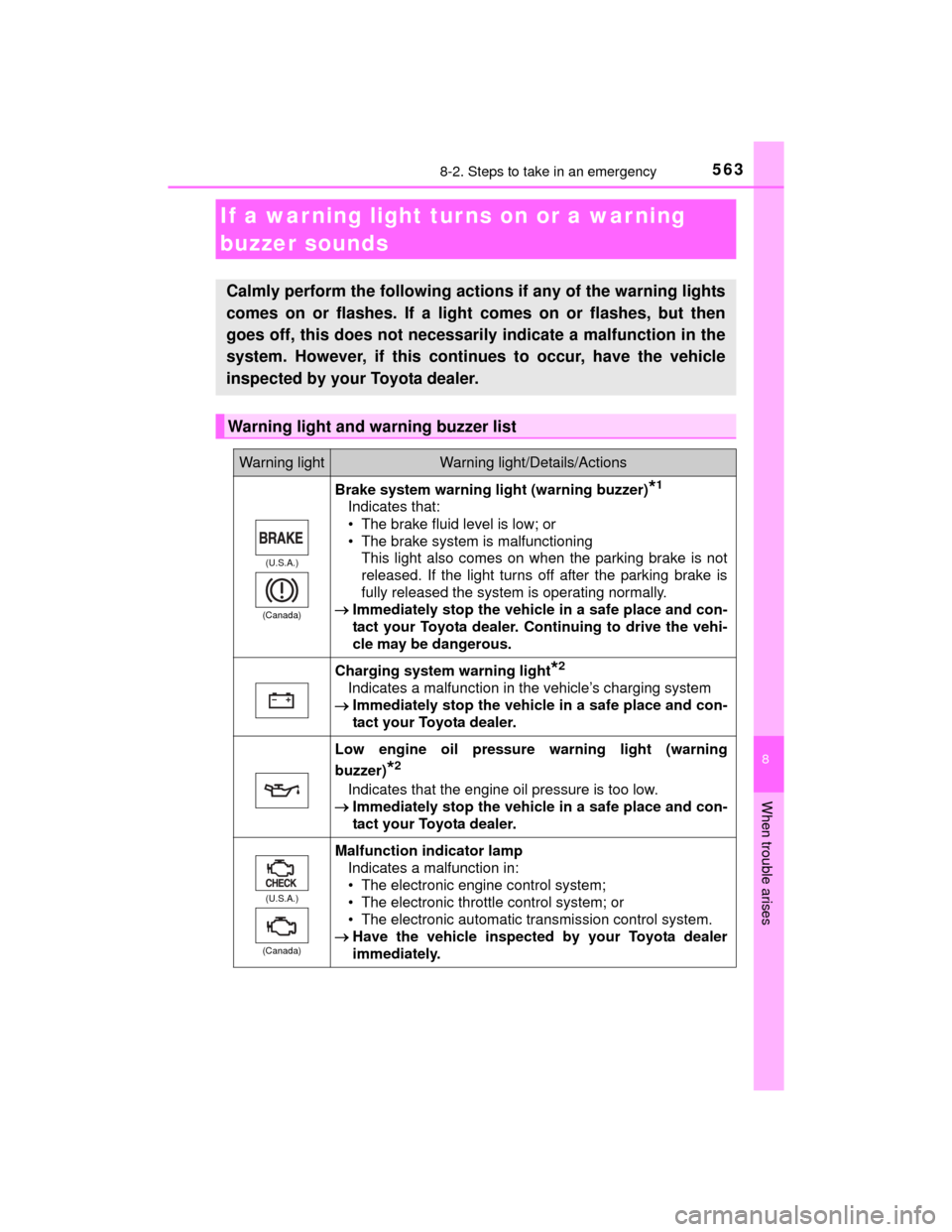
5638-2. Steps to take in an emergency
8
When trouble arises
HIGHLANDER_U (OM48A12U)
If a war ning light tur ns on or a war ning
buzzer sounds
Calmly perform the following actions if any of the warning lights
comes on or flashes. If a light comes on or flashes, but then
goes off, this does not necessarily indicate a malfunction in the
system. However, if this continues to occur, have the vehicle
inspected by your Toyota dealer.
Warning light and warning buzzer list
Warning lightWarning light/Details/Actions
(U.S.A.)
(Canada)
Brake system warning light (warning buzzer)*1
Indicates that:
• The brake fluid level is low; or
• The brake system is malfunctioning This light also comes on when the parking brake is not
released. If the light turns off after the parking brake is
fully released the system is operating normally.
Immediately stop the vehicle in a safe place and con-
tact your Toyota dealer. Continuing to drive the vehi-
cle may be dangerous.
Charging system warning light*2
Indicates a malfunction in the vehicle’s charging system
Immediately stop the vehicle in a safe place and con-
tact your Toyota dealer.
Low engine oil pressure warning light (warning
buzzer)
*2
Indicates that the engine oil pressure is too low.
Immediately stop the vehicle in a safe place and con-
tact your Toyota dealer.
(U.S.A.)
(Canada)
Malfunction indicator lamp Indicates a malfunction in:
• The electronic engine control system;
• The electronic throttle control system; or
• The electronic automatic transmission control system.
Have the vehicle inspected by your Toyota dealer
immediately.
Page 569 of 712
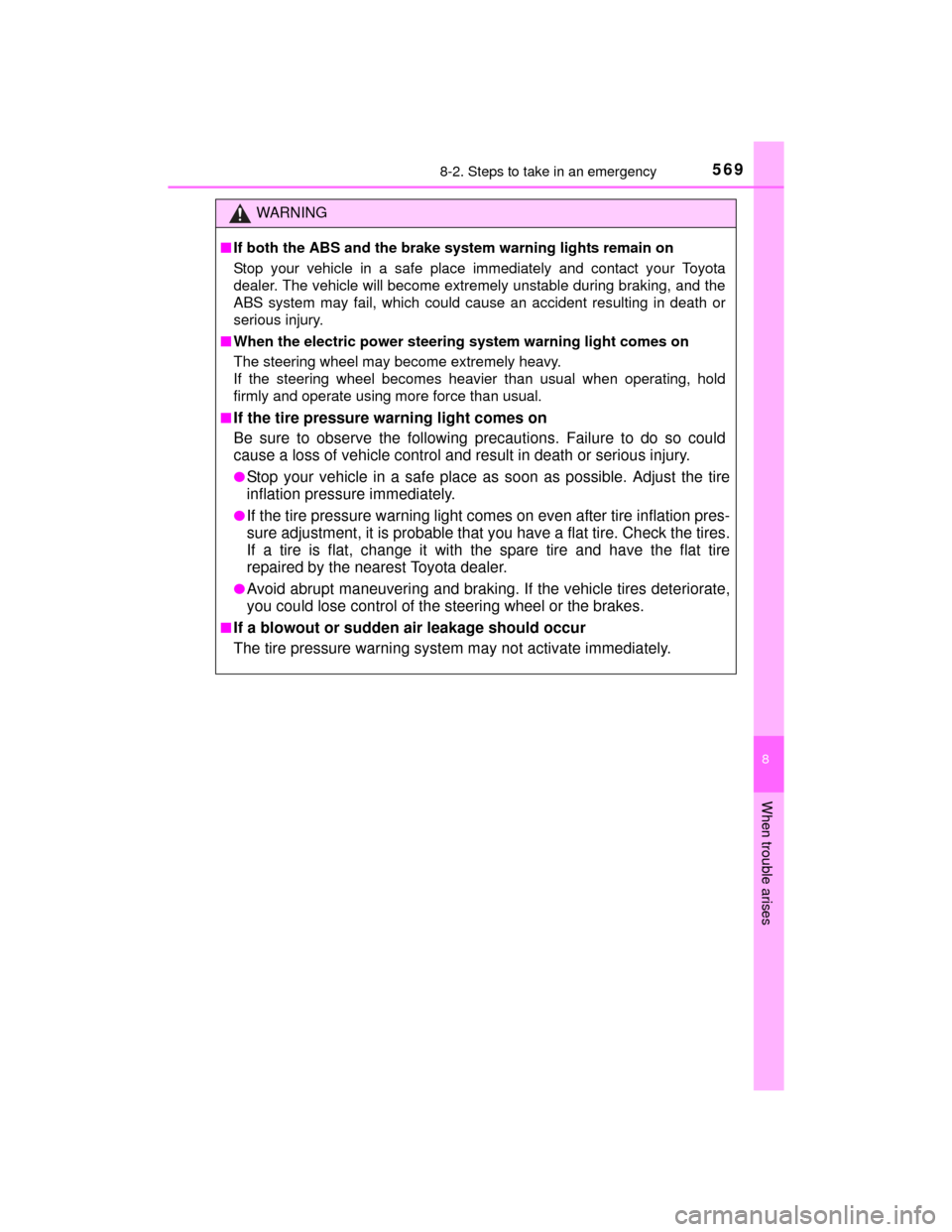
5698-2. Steps to take in an emergency
8
When trouble arises
HIGHLANDER_U (OM48A12U)
WARNING
■If both the ABS and the brake system warning lights remain on
Stop your vehicle in a safe place immediately and contact your Toyota
dealer. The vehicle will become extremely unstable during braking, and the
ABS system may fail, which could cause an accident resulting in death or
serious injury.
■ When the electric power steerin g system warning light comes on
The steering wheel may become extremely heavy.
If the steering wheel becomes heavier than usual when operating, hold
firmly and operate using more force than usual.
■
If the tire pressure warning light comes on
Be sure to observe the following precautions. Failure to do so could
cause a loss of vehicle control and result in death or serious injury.
●Stop your vehicle in a safe place as soon as possible. Adjust the tire
inflation pressure immediately.
●If the tire pressure warning light comes on even after tire inflation pres-
sure adjustment, it is probable that you have a flat tire. Check the tires.
If a tire is flat, change it with the spare tire and have the flat tire
repaired by the nearest Toyota dealer.
●Avoid abrupt maneuvering and braking. If the vehicle tires deteriorate,
you could lose control of the steering wheel or the brakes.
■If a blowout or sudden air leakage should occur
The tire pressure warning system may not activate immediately.
Page 580 of 712
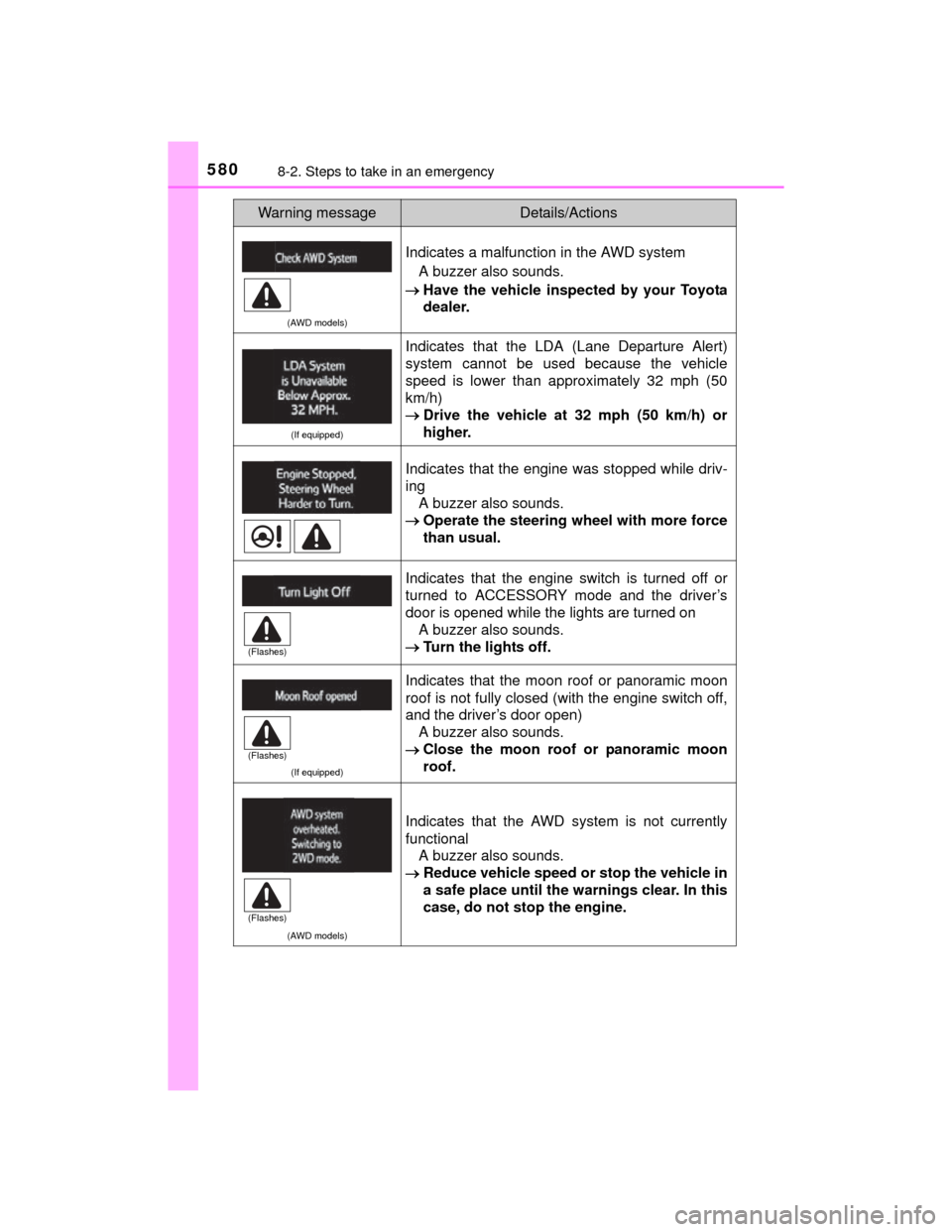
5808-2. Steps to take in an emergency
HIGHLANDER_U (OM48A12U)
(AWD models)
Indicates a malfunction in the AWD systemA buzzer also sounds.
Have the vehicle inspected by your Toyota
dealer.
(If equipped)
Indicates that the LDA (Lane Departure Alert)
system cannot be used because the vehicle
speed is lower than approximately 32 mph (50
km/h)
Drive the vehicle at 32 mph (50 km/h) or
higher.
Indicates that the engine was stopped while driv-
ing
A buzzer also sounds.
Operate the steering wheel with more force
than usual.
Indicates that the engine switch is turned off or
turned to ACCESSORY mode and the driver’s
door is opened while the lights are turned on
A buzzer also sounds.
Turn the lights off.
(If equipped)
Indicates that the moon roof or panoramic moon
roof is not fully closed (with the engine switch off,
and the driver’s door open)
A buzzer also sounds.
Close the moon roof or panoramic moon
roof.
(AWD models)
Indicates that the AWD system is not currently
functional
A buzzer also sounds.
Reduce vehicle speed or stop the vehicle in
a safe place until the warnings clear. In this
case, do not stop the engine.
Warning messageDetails/Actions
(Flashes)
(Flashes)
(Flashes)
Page 583 of 712
5838-2. Steps to take in an emergency
8
When trouble arises
HIGHLANDER_U (OM48A12U)
*: Refer to the separate “Scheduled Maintenance Guide” or “Owner’s ManualSupplement” for the maintenance interval applicable to your vehicle.
(If equipped)
Indicates that the Automatic High Beam switch is
pressed while the headlights are in low beam.
Turn the high beam on and press the Auto-
matic High Beam switch again.
Color display only
(If equipped)
Indicates that, since the VSC (Vehicle Stability
Control) system was turned off, the pre-collision
brake system operation is stopped
Turn the VSC on. ( P. 301)
Color display only
(If equipped)
Indicates that the PCS (Pre-collision system) is
not currently functional because the grille cover
or the sensor is dirty
Check the grille cover and the sensor and
clean them if they are dirty.
Warning messageDetails/Actions
(Flashes)
Page 615 of 712
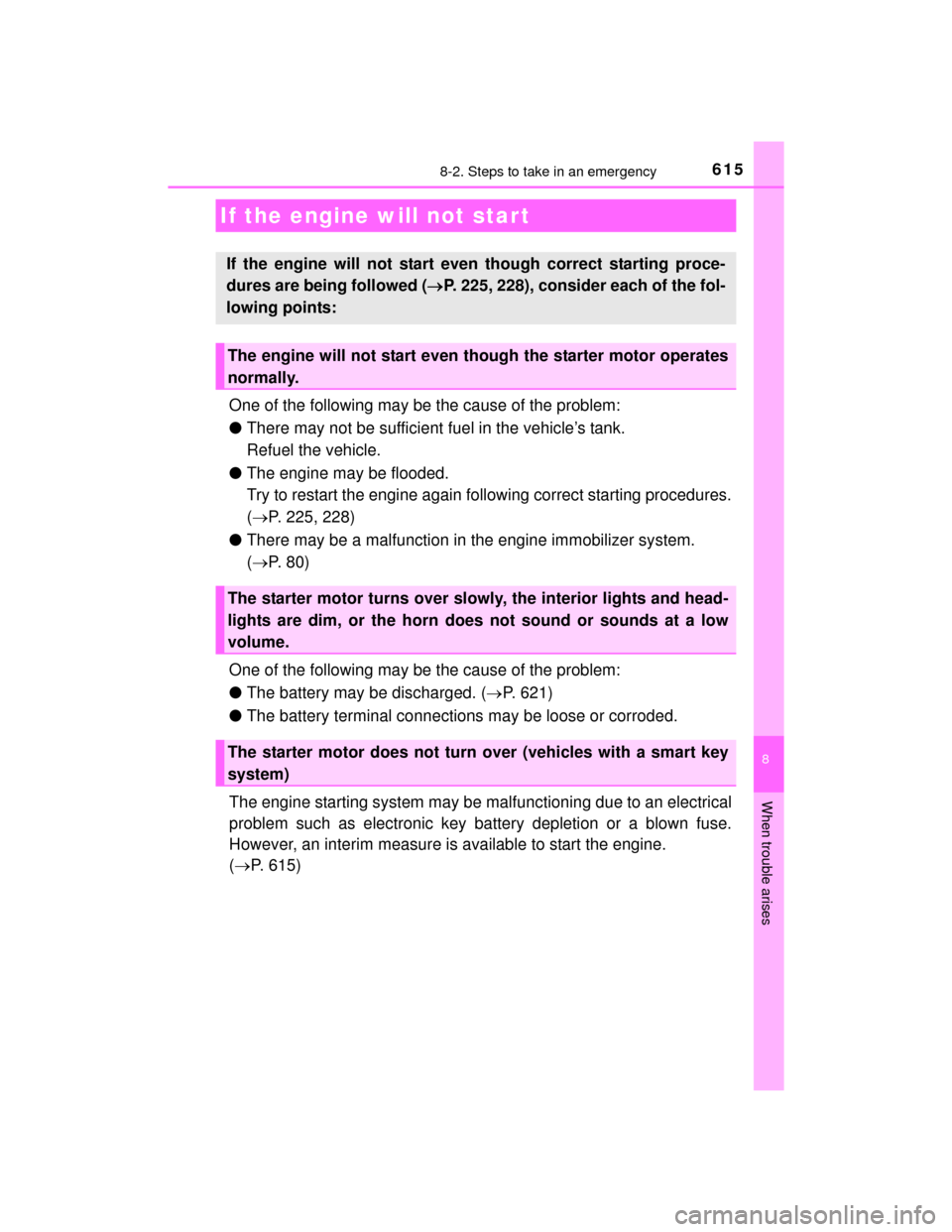
6158-2. Steps to take in an emergency
8
When trouble arises
HIGHLANDER_U (OM48A12U)
One of the following may be the cause of the problem:
●There may not be sufficient fuel in the vehicle’s tank.
Refuel the vehicle.
● The engine may be flooded.
Try to restart the engine again following correct starting procedures.
( P. 225, 228)
● There may be a malfunction in the engine immobilizer system.
( P. 8 0 )
One of the following may be the cause of the problem:
● The battery may be discharged. ( P. 621)
● The battery terminal connections may be loose or corroded.
The engine starting system may be malfunctioning due to an electrical
problem such as electronic key battery depletion or a blown fuse.
However, an interim measure is available to start the engine.
( P. 615)
If the engine will not start
If the engine will not start even though correct starting proce-
dures are being followed ( P. 225, 228), consider each of the fol-
lowing points:
The engine will not start even though the starter motor operates
normally.
The starter motor turns over slowly, the interior lights and head-
lights are dim, or the horn does not sound or sounds at a low
volume.
The starter motor does not turn over (vehicles with a smart key
system)
Page 616 of 712
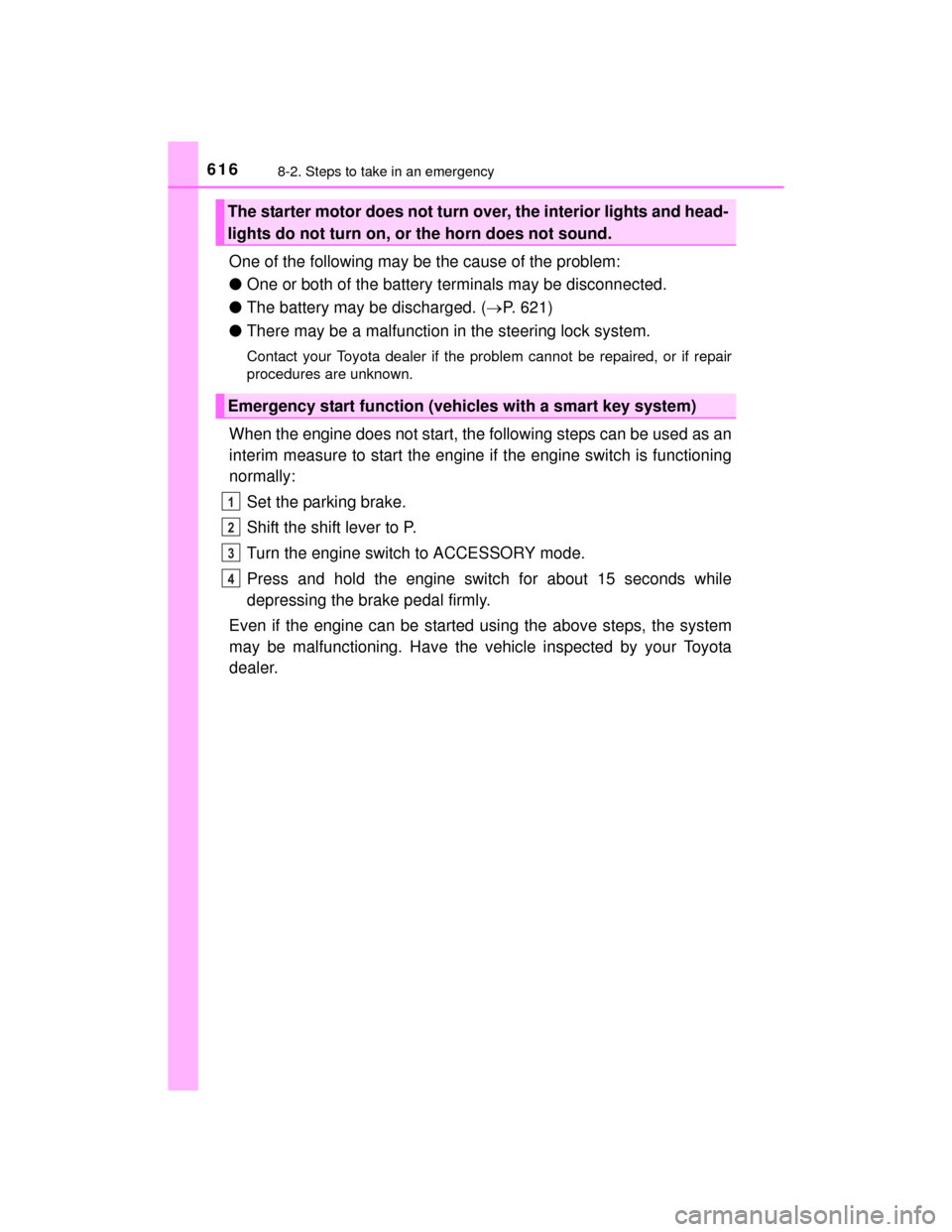
6168-2. Steps to take in an emergency
HIGHLANDER_U (OM48A12U)
One of the following may be the cause of the problem:
●One or both of the battery terminals may be disconnected.
● The battery may be discharged. ( P. 621)
● There may be a malfunction in the steering lock system.
Contact your Toyota dealer if the problem cannot be repaired, or if repair
procedures are unknown.
When the engine does not start, the following steps can be used as an
interim measure to start the engine if the engine switch is functioning
normally:
Set the parking brake.
Shift the shift lever to P.
Turn the engine switch to ACCESSORY mode.
Press and hold the engine switch for about 15 seconds while
depressing the brake pedal firmly.
Even if the engine can be started using the above steps, the system
may be malfunctioning. Have the vehicle inspected by your Toyota
dealer.
The starter motor does not turn over, the interior lights and head-
lights do not turn on, or the horn does not sound.
Emergency start function (vehicles with a smart key system)
1
2
3
4
Page 624 of 712

6248-2. Steps to take in an emergency
HIGHLANDER_U (OM48A12U)
■Starting the engine when the battery is discharged
The engine cannot be started by push-starting.
■ To prevent battery discharge
●Turn off the headlights and the audio system while the engine is off.
● Turn off any unnecessary electrical components when the vehicle is running
at a low speed for an extended period, such as in heavy traffic.
■ When recharging or replacing the battery
●Vehicles with a smart key system: In some cases, it may not be possible to
unlock the doors using the smart key system when the battery is dis-
charged. Use the wireless remote control or the mechanical key to lock or
unlock the doors.
● Vehicles with a smart key system: The engine may not start on the first
attempt after the battery has recharged but will start normally after the sec-
ond attempt. This is not a malfunction.
● Vehicles with a smart key system: The engine switch mode is memorized by
the vehicle. When the battery is reconnected, the system will return to the
mode it was in before the battery was discharged. Before disconnecting the
battery, turn the engine switch off.
If you are unsure what mode the engine switch was in before the battery dis-
charged, be especially careful when reconnecting the battery.
● Vehicle with power back door: The power back door must be initialized.
(P. 672)
■ Charging the battery
The electricity stored in the battery will discharge gradually even when the
vehicle is not in use, due to natural discharge and the draining effects of cer-
tain electrical appliances. If the vehicle is left for a long time, the battery may
discharge, and the engine may be unable to start. (The battery recharges
automatically during driving.)
Page 639 of 712
6399-1. Specifications
9
Vehicle specifications
HIGHLANDER_U (OM48A12U)
*: The fluid capacity is a reference quantity. If replacement is necessary, contact your Toyota dealer.
Electrical system
Battery
Open voltage at 68 F
(20 C): 12.6 12.8 V Fully charged
12.2
12.4 V Half charged
11 . 8
12.0 V Discharged
(Voltage is checked 20 minutes after the engine
and all lights are turned off.)
Charging rates5 A max.
Automatic transaxle
Fluid capacity*
2.7 L 4-cylinder (1AR-FE) engine
6.9 qt. (6.5 L, 5.7 Imp. qt.)
3.5 L V6 (2GR-FE) engine
2WD models:
6.9 qt. (6.5 L, 5.7 Imp. qt.)
AWD models:
7.1 qt. (6.7 L, 5.9 Imp. qt.)
Fluid typeToyota Genuine ATF WS
NOTICE
■ Automatic transmission fluid type
Using automatic transmission fluid other than “Toyota Genuine ATF WS”
may cause deterioration in shift quality, locking up of your transmission
accompanied by vibration, and ultimately damage the automatic transmis-
sion of your vehicle.